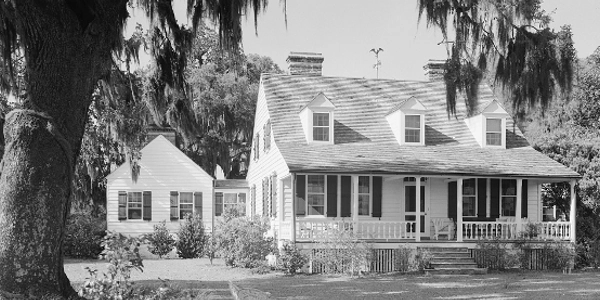
Photo above: Carriage house that now serves as the Visitor Center and Museum of the Oatlands Plantation, Leesburg, Virginia.
America's Best History Spotlight
On this page we're going to Spotlight the lesser known historic sites and attractions that dot the history landscape across the USA and are worth a visit if you're in their area. And while they may be lesser known, some are very unique, and will be that rare find. You'll be, at times, on the ground floor, or maybe even know something others don't. It'll be fun. Visit them.

Oatlands Plantation
It was grounds once owned by a man, King Carter, whose holdings in Virginia were of such gargantuan size, they might have been a state all on their own. Three hundred thousand acres were his holdings. Oatlands was just a modest acreage, three thousand four hundred and eight, owned by his grandson and awarded to his son, George Carter. Situated seven miles south of Leesburg, Virginia, this plantation was lived in by only two families in its history, the Carter and subsequent Eustis clan, with Civil War and slave holding past, and now sits in a pastural setting off Route 15 as a reminder of the wealth and lifestyle of the area. Today, you can read waysides about the Civil War camps and headquarters days following the Battle of Balls Bluff, step into the former carriage house and now Visitor Center and Museum, then take a guided tour of the Federal/Georgian home that housed the families which oversaw them all. Image above: Oatlands Mansion today with large Magnolia tree in front.
- Info
- What is There Now
- History Nearby
-

Oatlands Plantation
It was 1798, and George Carter had just been deeded the over three thousand acres that he'd later call Oatlands. He was a descendent of King Carter, great grandson, who was a colonist, Virginia governor, and one of the wealthiest men in the nation, King Carter at one time owned 300,000 acres of land and 1,000 slaves. However, the slave trade was not agreed upon by Robert Carter III, George's father. He began freeing the family slaves in 1791, only to have son George attempt to stop him and eventually utilize them again to allow him to prosper on the fields of Oatlands.
The Civil War brought changes to Oatlands, with occupation by Confederate forces, and an eventual change to the slave work population. Oatlands and the Carter family would not endure the post-war period with the same luxury, eventually using the property as a girl's school and summer boarding house. The property only went through two other owners; a short stint owned by the editor of the Washington Post who never lived there, and the Eustis family, who shouldered the plantation and grounds from 1903 to 1964. They were a prominent Washington family who wanted a summer retreat for equestrian, gardening, and other pursuits.
The property has been available for public use since the Eustis family donation to the Trust for Historic Preservation. Today you can wander the grounds with its farming, slave holding, and Civil War past and learn of the affluent times in later years of the Eustis family.
Image above: One view of the garden at Oatlands Plantation during the fall.
-
Oatlands Plantation
What's There
Carriage House - Now serves as the Visitor Center and Museum, with exhibits, a museum shop, tearoom, and visitor facilities.
Greenhouse - Constructed in 1810 by the Carter family. Thought to be the oldest standing greenhouse in the southern U.S.A.
Bachelor's Cottage - Built around 1821 for boarders and as a guest cottage.
Oatlands Mansion - Constructed in 1804 by the Carter family in the Federal/Georgian style with renovations in 1820 that reflected Greek Revival.
Terraced and Walled Garden - Four and one half acres of statuary and gardens with associated buildings, smokehouse, and laundry.
Picnic grove and other buildings on four hundred and fifteen acres.
How Much to Visit
$15 Adults - Grounds and House Tour.
$10 Adults - Grounds only.
$8 Children - Ages 6-16.
Free - Under 6 years old.
Hours Open
Monday to Saturday 10:00 a.m. to 5:00 p.m. Sunday Noon to 5:00 p.m. Tours on the hour. Additional tours available.
Where Is It Located
Oatlands Plantation is located at 20850 Oatlands Plantation Lane, Route 15, Leesburg, Virginia 20175. It is seven miles south of Leesburg on Route 15, only 45 minutes from Washington, D.C.
Website - Oatlands Historic House and Garden
-
Leesburg Historic Sites
So what else is there to do near the Oatlands Plantation? Well, there's the Balls Bluff Battlefield, Morven Plantation, the Marshall House, and downtown Leesburg with historic houses, courthouse, and other buildings.
Balls Bluff Battlefield
Downtown Leesburg
Morven
Marshall House
Photos, History, and More Spotlights

Carter Family Years
George Carter was the son of Robert Carter III, the grandson of King Carter. Despite their slave past, George's father Robert was anti-slavery and freed over four hundred slaves during his life. This did not fall down on George, however, who at one time, with his wife, held one hundred and thirty-three slaves on the grounds of Oatlands.
The Carter family would farm the acreage of Oatlands with crops of wheat, other grains, and sheep farming. They would operate a grist mill on Goose Creek, with production of grain, timber, and flax seed oil.
Civil War History and Oatlands
Sons of George Carter, George and Benjamin, both served in the Civil War for the South, enlisting on June 29, 1861. Benjamin would fight in the Battle of Balls Bluff on October 21, 1861, only seven miles from his home, and sustain a minor injury. General Nathan Evans and his staff, plus soldiers, would camp at Oatlands Plantation for ten days after the Battle of Balls Bluff. That and the Civil War moving into the area prompted the mother of George and Benjamin, Elizabeth Carter, to move from Oatlands to another property, Bellefield, in Upperville. She would never return full-time to Oatlands.
Martin VanBuren Jackson was born to a free black woman and enslaved black man owned by Elizabeth Carter. He would serve in the Union Army from 1863 in the 2nd Regiment of the U.S. Colored Infantry.
Photo above: Ruins of the Carter Mill on Goose Creek. Date unknown. Historic American Buildings Survey. Courtesy Library of Congress.

Eustis Family Years
William Corcoran Eustis and Edith Livingston Morton Eustis bought Oatlands from William Hutchins, the Washington Post editor, in 1903. Hutchins never lived there. They restored the gardens, upgraded the home with modern conveniences and began to socialize with some of the most elite folks of their era. Who befriended the Eustis family? General George C. Marshall, Henry Cabot Lodge, President Harry Truman, and President Franklin Delano Roosevelt and wife Eleanor.
Photo above: View of the acreage from the front porch of the Oatlands mansion, looking east. Below: Another view within the four and one half acre Oatlands walled garden.


Photo above: Wayside exhibit near the parking lot of Oatlands explaining the role of the plantation during the Civil War, including the encampment by Confederate soldiers after the Battle of Balls Bluff in 1861.

September Spotlight
More Spotlights
Charles Pinckney National Historic Site, Charelston, South Carolina
About
America's Best History where we take a look at the timeline of American History and the historic sites and national parks that hold that history within their lands.
Photos courtesy of the Library of Congress, National Archives, National Park Service, americasbesthistory.com and its licensors.


